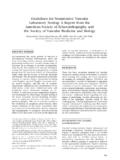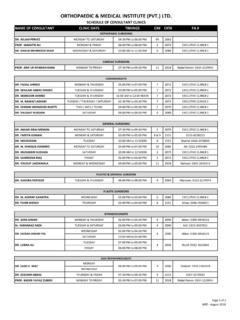Transcription of AS PSYCHOLOGY (7181/1) - filestore.aqa.org.uk
1 SPECIMEN MATERIAL AS PSYCHOLOGY (7181/1) Paper 1 Introductory Topics in PSYCHOLOGY 2016 Morning Time allowed: 1 hour 30 minutes Materials For this paper you may have: a calculator. Instructions Use black ink or black ball-point pen. Fill in the boxes at the bottom of this page. Answer all questions. You must answer the questions in the spaces provided. Do not write outside the box around each page or on blank pages. Do all rough work in this book. Cross through any work you do not want to be marked. Information The marks for questions are shown in brackets. The maximum mark for this paper is 72. Questions should be answered in continuous prose. You will be assessed on your ability to: - use good English - organise information clearly - use specialist vocabulary where appropriate. Please write clearly, in block capitals, to allow character computer recognition. Centre number Candidate number Surname Forename(s) Candidate signature 2 Section A Social influence Answer all questions in this section Only one answer per question is allowed.
2 For each answer completely fill in the circle alongside the appropriate answer. If you want to change your answer you must cross out your original answer as shown. If yo u wish to return to an answer previously crossed out, ring the answer you now wish to select as shown. Which two of the following are types of conformity? Shade two boxes only. A Agentic state B Compliance C Group size D Identification E Unanimity [2 marks] Briefly outline and evaluate the authoritarian personality as an explanation of obedience to authority. [4 marks] 0 1 0 2 CORRECT METHOD WRONG METHODS 3 Turn over Read the item and then answer the question that follows. The following article appeared in a newspaper: Britain s views on homosexuality the biggest social change of the last 30 years? In the UK, views on homosexuality have changed significantly in recent times. Thirty years ago, almost two-thirds of the British public opposed same-sex relationships because they were morally wrong.
3 These days, homosexuality is accepted and the majority of British people support recent changes to the laws on gay marriage and adoption. With reference to the article above, explain how social influence leads to social change. [6 marks] Extra space 0 3 4 Describe and evaluate two studies of social influence. [12 marks] 0 4 You may use this space to plan your answer. 5 Turn over Extra space Turn over for the next section 6 Section B Memory Answer all questions in this section Only one answer per question is allowed. For each answer completely fill in the circle alongside the appropriate answer. If you want to change your answer you must cross out your original answer as shown. If yo u wish to return to an answer previously crossed out, ring the answer you now wish to select as shown. Complete the following statement about long-term memory. Shade one box only.
4 Information stored with reference to time and place refers to: A Episodic memory B Procedural memory C Semantic memory [1 mark] Complete the following statement about long-term memory. Shade one box only. Information not available for conscious inspection refers to: A Episodic memory B Procedural memory C Semantic memory [1 mark] 0 5 . 1 0 5 . 2 CORRECT METHOD WRONG METHODS 7 Turn over Read the item and then answer the questions that follow. Participants in an experiment were shown a film of a robbery. The participants were then divided into two groups. One group was interviewed using a standard interview technique and the other group was interviewed using the cognitive interview technique. All participants were then given an accuracy score (out of 20) based on how closely their recall matched the events in the film (20 = completely accurate, 0 = not at all accurate). The results of the experiment are shown in Table 1.
5 Table 1: The median accuracy score for the standard interview and the cognitive interview Standard interview Cognitive interview Median 10 15 Sketch an appropriate graphical display to show the median accuracy scores in Table 1. [6 marks] 0 6 . 1 0 6 8 The experiment used an independent groups design. Explain how this study could have been modified by using a matched pairs design. [4 marks] Identify and outline two techniques that may be used in a cognitive interview. [4 marks] 0 6 . 2 0 7 9 Turn over Outline and evaluate research into the effects of leading questions on the accuracy of eyewitness testimony. [8 marks] Extra space 0 8 10 Section C Attachment Answer all questions in this section Only one answer per question is allowed. For each answer completely fill in the circle alongside the appropriate answer. If you want to change your answer you must cross out your original answer as shown.
6 If yo u wish to return to an answer previously crossed out, ring the answer you now wish to select as shown. In van Ijzendoorn s cross-cultural investigations of attachment, which one of the following countries was found to have the highest percentage of anxious-avoidant children? Shade one box only. A China B Germany C Great Britain D Japan [1 mark] In van Ijzendoorn s cross-cultural investigations of attachment, which one of the following countries was found to have the highest percentage of anxious-resistant children? Shade one box only. A China B Germany C Great Britain D Japan [1 mark] 0 9 . 1 0 9 . 2 CORRECT METHOD WRONG METHODS 11 Turn over In van Ijzendoorn s cross-cultural investigations of attachment, which one of the following attachment types was found to be most common in all of the countries investigated? Shade one box only. A Anxious-avoidant B Anxious-resistant C Disorganised D Secure [1 mark] In van Ijzendoorn s cross-cultural investigations of attachment, which one of the following statements is correct?
7 Shade one box only. A Cross-cultural studies of attachment only investigate the variation between cultures and not the variation within cultures B There was no difference in the variation within cultures compared to the variation between cultures C The variation between cultures was greater than the variation within cultures D The variation within cultures was greater than the variation between cultures [1 mark] Section C continues on the next page 0 9 . 3 0 9 . 4 12 Read the item and then answer the question that follows. Proud father Abdul was talking to his friend, as they were both watching Abdul s wife , Tasneem, interacting with their baby daughter, Aisha. It s amazing really , said Abdul. Tasneem smiles, Aisha smiles back. Tasneem moves her head, Aisha moves hers, perfectly in time with each other. Yes , agreed the friend. It s a lmost as if they are one person. With reference to Abdul s conversation with his friend, outline two features of caregiver-infant interaction.
8 [4 marks] 1 0 . 1 1 0 13 Turn over Read the item and then answer the question that follows. Studies of attachment often involve observation of interactions between mother and baby pairs like Tasneem and Aisha. Researchers sometimes write down everything that happens as it takes place, including their own interpretation of the events. Explain how such observational research might be refined through the use of behavioural categories. [4 marks] Section C continues on the next page 1 0 . 2 14 Read the item and then answer the question that follows. Joe was taken away from his alcoholic parents at six months old and placed in care. He was adopted when he was seven years old, but has a difficult relationship with his adoptive parents. He is aggressive towards his younger siblings and is often in trouble at school. His last school report said, Joe str uggles with classwork and seems to have little regard for the feelings of others.
9 Discuss Bowlby s maternal deprivation theory. Refer to the experience of Joe as part of your discussion. [12 marks] 1 1 You may use this space to plan your answer. 15 Extra space END OF QUESTIONS 16 There are no questions printed on this page DO NOT WRITE ON THIS PAGE ANSWER IN THE SPACES PROVIDED Copyright 2014 AQA and its licensors. All rights reserved.
















